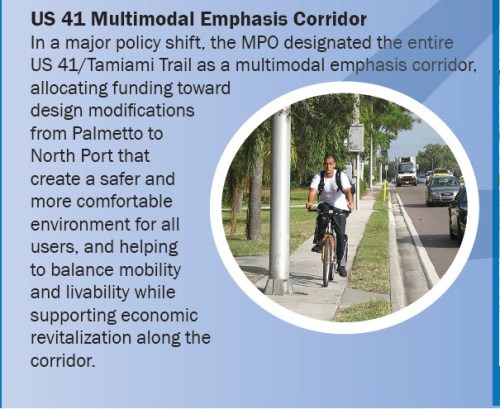USA Best Practice for All US41 Users: Multimodal
Multimodal?
Multimodal roadway designs consider more than just vehicles. USA best practice is design weight given to all users (walkers, bikers, bus riders, drivers) in a livable context that’s sensitive to residents and businesses along a corridor, safely maintaining travel time with less congestion, attractive aesthetics in landscaping, in ways more sustainable with less air and noise pollution
The outcome balances mobility and livability in ways that encourages economic revitalization. This website focuses on certain mobility Simple Truth principles that the multimodal objective will consider.
US41, from Palmetto to North Port, is now designated a Multimodal Emphasis Corridor (MEC) by the Sarasota Manatee Metropolitan Planning Organization (MPO), dedicating priority federal and state roadway funding in its 2035 Long Range Transportation Plan. The document see page 88 at www.mympo.org. 2035 LRTP US41 Multimodal Emphasis Corridor from Palmetto to North Port.
2035 LRTP US41 Multimodal Emphasis Corridor from Palmetto to North Port.
This US41 federal highway through Manatee and Sarasota County is four-lanes wide except for six-lane segments in the Venice US41 area, current and planned. To be clear, this website posits that six-lanes wide (wider at intersections) is a vehicle-speed-dominated width that bifurcates communities, adds injury risk to all users, depresses adjacent businesses by complicating entry/exit, and exacerbates congestion with costly signalized intersections that will make drivers waste their fuel, their time, and pollute their air.
Four-lanes multimodal is the best practice cost/benefit equation that economically stimulates the adjacent businesses and best meets the MPO mission, paraphrased: deliver sooner safer and better mobility for the most people.
US41 multimodal four-lane treatments include modern roundabouts, the “Wide Nodes, Narrow Roads” corridor design advocated by the Federal Highway Administration (FHWA) (Wide Nodes/Narrow Road). “Signalized intersections operate most efficiently when they manage the advancement of platoons of traffic. This requires sufficient through lanes between signals to maintain the integrity of these platoons. Roundabouts, on the other hand, produce efficiency through a gap acceptance process and thus do not carry the same need for platoon progression. As a result, roundabouts can be made as large as needed for node capacity, keeping the links between nodes more narrow. This concept is sometimes referred to as a “wide nodes, narrow roads” concept. The reduced number of travel lanes between intersections may make it feasible to reduce right-of-way impacts and to accommodate parking, wider sidewalks, planter strips, and bicycle lanes, etc. http://safety.fhwa.dot.gov/intersection/roundabouts/fhwasa10006/. and clickFHWA Purdue Presentation March 2012
Simple Truths: Certain simple mobility truths today are widely recognized by experienced transportation engineers across the USA. These truths argue against widening an arterial corridor, such as the Venice ByPass, where traffic flow is interrupted by a series of intersections. For multimodal sake, these simple truths:
Webmaster: Rod Warner, a Sarasota County representative to the MPO Citizen Advisory Committee (a past chair), team member US41Momentum (www.US41momentum.wordpress.com) and FHWA Peer2Peer Program http://safety.fhwa.dot.gov/intersection/roundabouts/p2p/
